屺园
——园艺小镇文创中心
2019-09-02建筑设计李兴钢谭泽阳姜汶林中国建筑设计研究院有限公司
建筑设计:李兴钢,谭泽阳,姜汶林/中国建筑设计研究院有限公司
2019 北京世园会园艺小镇用地西南,构建了一处既“开放”又“封闭”的公共空间。
场地东北依托传统风貌的特色小镇和花田,南侧与现代化的植物馆遥望。建筑化整为零,由4 个单坡屋顶两两组合形成的L 形体量围合而成。一条内巷将两个体量区隔开来,半高的基座又将彼此连缀。内巷在西北、东南对角方向设置公共漫游出入口,成为园区公共游览系统的一部分,游客经由内巷上达平台,攀至屋顶,赏望远景。使用空间在西南、东北和东南角分设出入口,互不相扰:西南体量为以展厅、讲堂和图书吧为主的文创服务空间;东北体量以制作工坊、纪念品商店等特色产业体验1空间为主;基座下设置管理办公用房和艺术家工作室,与服务区和产业区便捷相连。各组团可分可合,会时各安其位,统一管理;会后亦可合而为一,共同运营。
开放性之余,建筑又希望能实现某种内在叙事,从而跟周边环境中那些非自然的布景式建筑或景观保持适当距离。将建筑进行两分,“筑房拟山”,完成一种特定的景观体验——单坡屋面赋予建筑以强烈的方向性和识别性,同时也完成了象征自然物的“山”与象征人工物的“房”之间的连接和互成:“房”以“山”为对景,位于东北侧;“山”与“房”的基座相连,位于西南侧。相似的坡顶形式,在室内分化成两类不同特征的空间:西南侧体量趴伏,空间呈现出洞穴般的模糊性;东北侧间架清晰,暗合了传统建筑的空间特征;半高的平台将“山”与“房”既隔且连,使西南坡顶成为东北侧“房”内特殊的
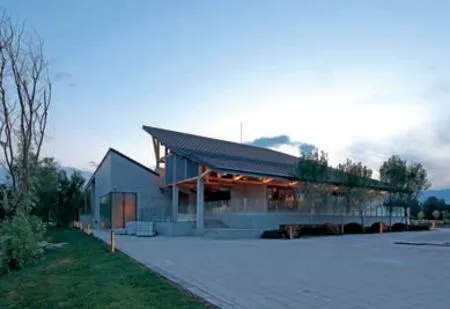
2
1 植物馆北望,木屋架托起的单坡屋面迎向一片绿树/Viewing from Botanic Garden to the north, the single-slope roof supported by the wooden frame faces a stretch of green trees
2 东南侧人视,“山”与“房”若即若离的关系形成主入口/Viewing from the southeast side, the separation of "mountain"and "house" forms the main entrance人造“山”景,谓之以“房”现“山”。 “山”“房”檐廊、阁楼、亭台共同构成一个立体的观游系统,故名“屺园”。
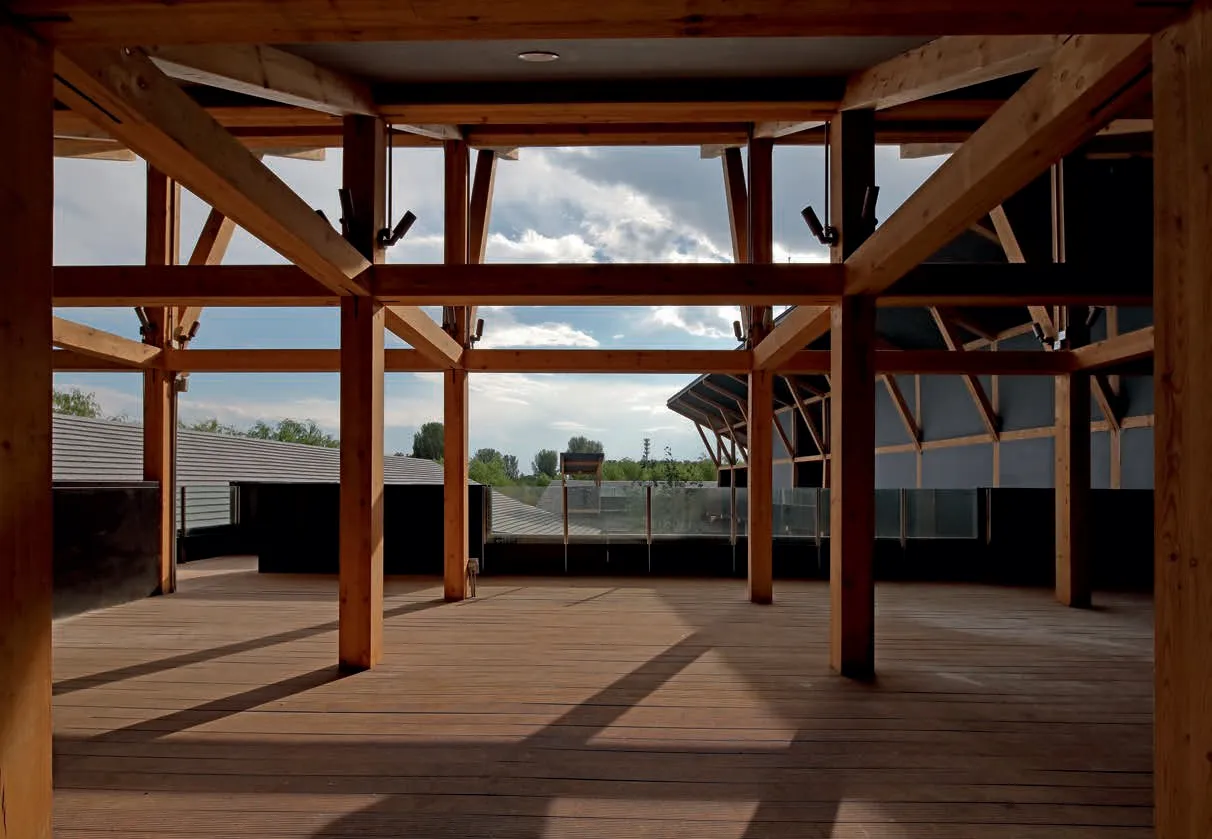
3
“山”的部分采用全现浇清水混凝土墙体承托斜屋面,强化“山穴”的空间特征;“房”的部分采用钢筋混凝土框架与木屋架复合的结构体系,象征传统的木作屋架。“房”中的木屋架采用正交木桁架,等截面的木杆件通过预制的多向钢构件连接,形成既现代高效,又与传统榫卯木作有所关联的复合式节点。
项目信息/Credits and Data
客户/Client: 北京世园投资发展有限责任公司/Beijing Shiyuan Investment Development Co., Ltd.
主持建筑师/Principal Architect: 李兴钢/LI Xinggang
设计团队/Design Team: 谭泽阳,姜汶林,袁智敏,谭舟(建筑);刘文珽,杨松霖(结构);申静,郝洁(给排水);祝秀娟,刘维(暖通);王旭,王昊(电气)/TAN Zeyang, JIANG Wenlin, YUAN Zhimin, TAN Zhou(Architecture); LIU Wenting, YANG Songlin (Structure),SHEN Jing, HAO Jie (Plumbing), ZHU Xiujuan, LIU Wei(HVAC), WANG Xu, WANG Hao (Electrical)
材料/Materials: 混凝土,木/Concrete, wood
项目面积/Project Area: 2310m2
造价/Cost: 约2300万人民币/Approx. 23M CNY
设计时间/Design Time: 2018.01
竣工时间/Completion Time: 2019.04
绘图/Drawings: 姜汶林/JIANG Wenlin
摄影/Photos: 张广源/ZHANG Guangyuan (fig.1-3,5,6,8),李维纳/LI Weina (fig.4,7),姜汶林/JIANG Wenlin (fig.9)

4
3 二层阁楼,透过木屋架西望瓦屋面与景亭/First floor attic,viewing tile roof and pavilion through the wooden frame to the west
4 总平面/Site plan

5

6
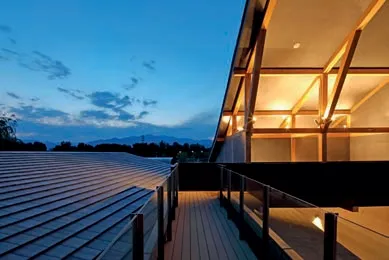
7

8
1-展厅/Exhibition hall
2-办公区门厅/Reception for the office 3-艺术家工作室/Artist's studio
4-艺术家展廊/Gallery
5-展区门厅/Reception for the exhibition
6-多功能讲堂/Multifunctional auditorium 7-讲堂前厅/Reception for the auditorium
8-图书咖啡吧/Library & coへee bar 9-吧台/Bar counter
10-文创区门厅/Reception for the culture creation area
11-纪念品商店/Souvenir store
12-制作工坊/Workshop
13-休息观景平台/Veiwing platform
14-滨水咖啡平台/Waterfront coへee platform 15-庭院/Courtyard
16-室外花房/Outdoor greenhouse

9
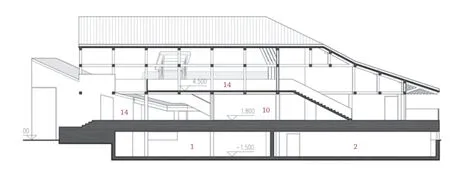
10
5 二层檐廊,向南倾斜的木斜撑和狭窄的通道对身体形成特殊的引导/First floor eaves gallery, slanted wooden supports to the south and narrow passageways provide special guidance to the body
6 瓦屋面上反的混凝土墩承托了树状木屋架,成为“山”和“房”的中介物/The concrete pier on the reverse side of the tiled house supports the treelike wooden frame, which becomes the intermediary between "mountain" and "house"
7 玻璃廊道轻架在瓦屋面上,将视线引向远山/The glass corridor is light on the tiled roof, leading to the distant mountains
8 首层平面/Ground floor plan
9.10 剖面/Sections
Horticulture Village of Beijing Horticultural Exhibition 2019, which sits in the southwest of the site, produces a both "open" and "closed" space.
The northeast area of the site relies on the small towns with traditional characteristic features while the south side echoes the modern Botanical Pavilion from afar. The building is divided from a whole body into parts, surrounded by the L-shaped volumes formed by two pairs of four single-pitched roofs. The two volumes are separated by an inner alley and connected by a half-height pedestal. The public roaming entrance and exit are set to the inner alley which is located from northwest to southeast diagonally, becoming a part of the public tour system of the park. Visitors reach the platform through the inner alley, climb to the roof, and enjoy the vistas. Entrances and exits are placed independently without interference in the southwest, northeast and southeast corner of the usable spaces, with the southwest volume as a cultural and creative service space dominated by an exhibition hall, a lecture hall and a book bar, and the northeast as an characteristic industrial experience space featured by a manufacture workshop and a souvenir shop.Below the pedestal, there are management office rooms and an artist's studio, which conveniently connect to the service area and industrial area. Each group can be independent or combined, fitting its position under unified management during the exhibition and merges into an entirety operated together after.
In addition to openness, there is a kind of internal narrative which is hoped to be achieve in the architecture, so as to keep a proper distance from the unnatural scenery-style buildings or landscapes in the surrounding environment. The building is divided into two parts, which mean "resemble mountains through building houses", to complete a specific landscape experience, an intense directionality and identification endowed to the building due to singlepitched roofs, and also to accomplish the connection and mutual integration between the "mountain"symbolising natural objects and the "house"symbolising artefacts. The "house" as the opposite scenery of the "mountain", is located in the northeast while the "mountain" that connects to the base of the "house" is set in the southwest. Similar sloping roof forms are divided into two types of spaces with diへerent characteristics. The volume in the southwest is prone which present cave-like indistinct spaces,and the clear frames in the northeast implies the spatial characteristics of the traditional architecture.Half height platform separates and connects the"mountain" and the "house", making the southwest sloping roof become the special artificial "mountain"scenery in the "house" on the northeast side, which is called embodying "mountain" by "house". "mountain","house", eave galleries, attics, pavilions, together constitute a three-dimensional system of tour and view, hence named "Mountain Garden".
Entire cast-in-situ concrete walls support the inclined roof in the part of "mountain", which strengthens the spatial characteristics of a "cave".Composite structural system of reinforced concrete frame and timber roof truss is adopted in the part of "house", which resembles traditional wooden roof frame. The orthogonal timber trusses applied in the"house", in which wood members with uniform cross sections connect each other by prefabricated multidirectional steel members, form composite joints fashionably efficiently, and also connect traditional tenon-and-mortise works.

11
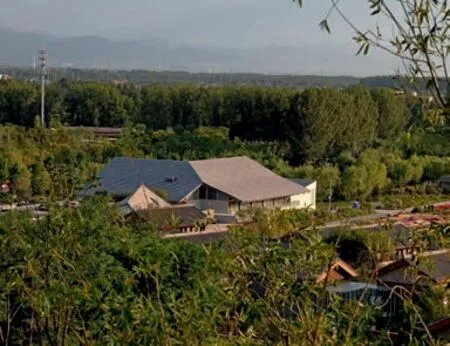
12

13
11 花田南望,坡顶漂浮于基座上,透出内部的另一层瓦屋面,以房现山/Viewing from the garden to the south, the roof of the slope floats on the base, revealing another layer of tile roof inside, showing the "mountain" through a "house"
12 永宁阁西望,瓦屋面与近处园艺小镇的坡顶形成对话/Viewing from the Yongning Pavilion to the west, the tile roof forms a dialogue with the slope roof of the nearby Horticulture Village
13 “山”内的洞穴空间,洞口结合多个标高的地面使空间深远不尽/The "cave-like" space in the "mountain", combined with multiple levels, makes the space far-reaching
